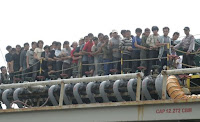Here's something for us to think about too as a nation ...
The survey of 2,000 people, conducted for the tabloid Sydney Daily Telegraph newspaper, found 51 percent thought "our population is too high (and) we should stop immigration".
Australia has some 23 million people, compared to 19.6 million a decade ago.
Canberra set its immigration programme for the year to June at 185,000 places, with another 13,750 slots available to refugees on humanitarian grounds.
But in the poll only 32 percent of respondents felt Australia should welcome more immigrants and almost two thirds, some 65 percent, said "migrants should adopt the Australian way of life".
The responses revealed a marked swing away from the more tolerant attitudes of previous surveys conducted in 2005, 2001 and 1995, the newspaper said.
Immigration expert Bob Birrell said fears over job security in the shaky global economy and local pressures on infrastructure were behind the shift in opinion.
The poll came as two asylum-seeker boats carrying some 82 passengers were intercepted off northern Australia on Monday -- taking the number of boats to arrive to four in as many days.
A total of 42 boats carrying 3,261 asylum seekers have arrived so far this year, causing Australia's refugee detention budget to spiral to more than Aus$1 billion (US$1 billion).
Though they come in relatively small numbers by global standards, the issue of asylum-seekers is a political flashpoint in Australia, dominating national elections in 2010, when a record 6,555 boatpeople arrived from Asia.
Immigration Minister Chris Bowen said the rush this year was "unsurprising" given the failure of a planned refugee swap deal with Malaysia in 2011 intended to deter people smuggling, after the High Court of Australia struck it down.
The government was forced to abandon offshore processing of asylum-seekers and release many detainees to live in the community after the conservative opposition blocked attempts to get around the ruling.
Bowen said it was essential to find more effective deterrents to stop people making the perilous maritime journey, usually from Indonesia.
"You are going to continue to see people arriving by boat which means you're going to continue to see deaths at sea," he said.
Copyright © 2012 AFP. All rights reserved



